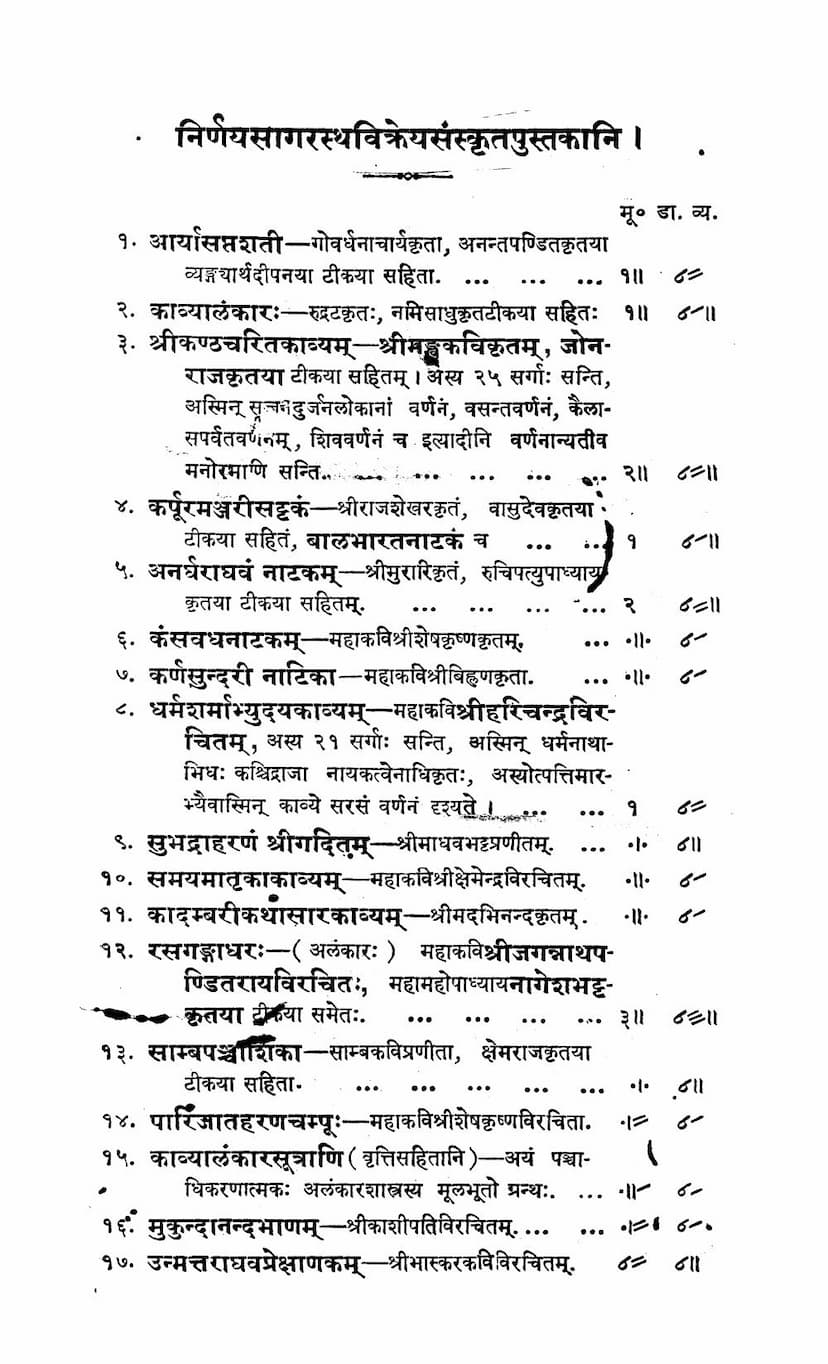Mruccha Katikam
Added to library: September 2, 2025

Summary
The provided text is a collection of pages from a Sanskrit book, specifically an edition of the Mṛcchakaṭikā by Śūdraka, with commentary. The pages primarily consist of a table of contents or a list of books available from the publisher "Nirṇayasāgara," followed by the preface and the plot summary of the Mṛcchakaṭikā in Sanskrit.
Here's a breakdown of the content, focusing on what is relevant to the Mṛcchakaṭikā:
Publisher Information:
- The publisher is identified as Tukārām Javājī, Proprietor of Javaji Dadaji's "Nirṇaya-Sāgara" Press, Bombay.
- The catalog link provided is for the Jain Library.
- The book was printed and published in Bombay, with the first edition dated 1902 (Śaka 1824).
- The price of the book is mentioned as two rupees.
Book Title and Author:
- The title is clearly "THE MRICHCHHAKATIKA OF S'ÜDRAKA".
- It is stated to be "WITH THE COMMENTARY OF PRITHVÎDHARA".
- The editing and notes in English, plot in Sanskrit, etc., are by Pandit Hîrânanda Mêlaraja Śarmâ S'âstrî M. A. and Kas'înâth Pâṇdurang Parab.
Preface (pp. 11-21):
The preface provides a detailed discussion about the Mṛcchakaṭikā (The Clay Cart):
- Title of the Play: It explains that the play is named after a central incident where the heroine Vasantasenâ fills the clay cart of Chârudatta's son, Rohasena, with her jewels. This toy becomes a source of trouble for the hero, as the ornaments later serve as proof of his alleged guilt in Vasantasenâ's murder.
- Author of the Drama:
- The play itself mentions Śūdraka, a "regal bard," as the author.
- However, the preface raises doubts about the authenticity of such autobiographical statements, pointing out literary forgeries and the tendency to attribute works to kings for advantage.
- It cites Professor Levi's remarks from "Le Théâtre Indien" regarding Śūdraka, noting that the name is familiar in literature but absent in literary history. Śūdraka is depicted as a legendary figure across various texts, with stories attributing diverse origins and adventures to him, making his historicity questionable and leaning towards fable.
- The preface supports Śūdraka's authorship based on old authorities like Vâmana who mentions him as an author of repute.
- It suggests the play might have been composed in South India due to its content and use of southern colloquial words, with Northern rhetoricians quoting it less frequently.
- Opinions of Critics:
- It discusses the theory proposed by Professor R. Pischel that Dandin might be the real author, based on similarities in the depiction of society between Mṛcchakaṭikā and Dandin's Daśakumāracarita, a shared verse discussed in Dandin's Kāvyādarśa, and an attribution by Pratihārendurāja.
- The preface refutes Pischel's theory by questioning the attribution of the verse, noting Dandin's own comments suggesting predecessors, and arguing that the similarity in depicting society doesn't prove single authorship. It also questions why Dandin would attribute the play to a mythical monarch.
- Date of the Play:
- Information about the play's date is scarce and unsatisfactory.
- Weber suggests it wasn't written before the 2nd century AD because of the word "Nânaka" (referring to coins). The preface counters this by stating Nânaka might have existed before Kânerki's era.
- Wilson considers it of respectable antiquity, but his arguments are deemed defective, particularly his point about the absence of Puranic figures. The preface refutes this by pointing out allusions to Puranic stories within the play itself. Wilson's second argument about suicide laws and the third about a Brahman's love for a courtesan are also considered inconsequential or not against Manu's ordinances.
- M. Williams considers it the earliest extant Sanskrit drama, possibly from the 1st century AD.
- Professor Lassen assigns it to around 150 AD.
- Windisch believes the play is old and influenced by Greek comedies in India, particularly during Menander's reign (144 BC).
- Facts Indicative of Antiquity:
- The play doesn't strictly adhere to rhetoricians' injunctions (e.g., pre-eminence to Rasa).
- Its style is simple and unartificial, unlike other contemporary works.
- The Prakritic dialects used are free from artificialities noticed in other dramatists.
- The accurate mention of Bauddha rites and the flourishing condition of Buddhism suggest a specific period.
- The play is posterior to the Mānavadharmaśāstra (quoted in Act IX) and possibly prior to Varāhamihira (based on astrological views mentioned).
- Merits of the Drama:
- The action has unity of interest and proceeds logically.
- It features variety of characters, with distinct inferior characters and singular combinations in superior ones.
- Samsthāna (Śakāra) is highlighted as a masterpiece of characterization—contemptible, malicious, yet frivolous.
- The play is praised for its life-like action, lack of exaggeration, and poetic imagery, though it might lack the depth of Kālidāsa or the weighty expressions of Bhavabhūti.
- It is noted for its originality, good sense, depiction of luxury, comic situations, serious scenes bordering on tragedy, vigor, and sharpness of characterization, drawing parallels to Shakespeare.
Plot Summary in Sanskrit (pp. 21-48):
This section provides a detailed, act-by-act summary of the play's plot in Sanskrit. It outlines the key events and character interactions in each of the ten acts.
Dramatis Personae:
This section lists the characters in the play, categorizing them into Men and Women, and also mentions characters who are spoken of but do not appear. It also specifies the scenes and time frame.
Dialects Used in the Play:
This section details the various Prakritic dialects used by different characters, including Saurasenî, Avanti, Prâchyâ, Mâgadhî, and Apabhramsa dialects like Śâkârî, Châṇḍâlî, and Ḍhakkâ.
In essence, the provided text is an introduction to the Mṛcchakaṭikā from a specific publisher, covering its bibliographical details, a critical examination of its authorship and date, and a summary of its plot, along with character lists and dialectical usage. The focus is on providing scholarly and historical context for the Sanskrit drama.